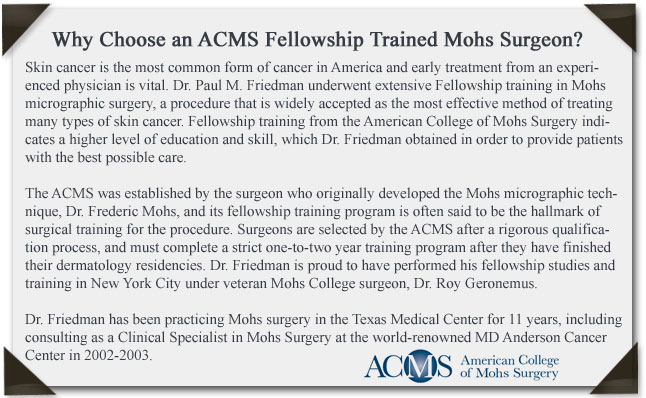There are several different types of skin cancer; skin cancer is a malignant growth on the skin that can be caused by a variety of factors. It generally begins in the epidermis, so a skin cancer tumor is clearly visible to the naked eye. This makes skin cancer detectable in the early stages, which also helps to make it more treatable.
Types of Skin Cancer
Basal Cell Carcinoma
Basal Cell Carcinoma, the most common form of skin cancer, may look like an open sore, may be a reddish patch or may be a waxy growth with an elevated border and central indentation. Treatment of this type of cancer may include:
- Mohs surgery
- Excision
- Radiation
Paul M. Friedman, M.D. has treated countless patients with various types of skin cancer.
Squamous Cell Carcinoma
Squamous Cell Carcinoma is another type of cancer that occurs most often on areas of the body that are exposed to the sun. Squamous cell carcinoma may look like a scaly red patch with borders that are irregular in shape. These lesions may also appear wart-like or like an open sore. These lesions may actually bleed if they are disturbed or bumped. The same types of treatments that are used for Basal Cell Carcinoma are also used for Squamous Cell Carcinoma.
Melanoma
The most dangerous type of skin cancer is melanoma. Melanoma may occur anywhere on the body. Melanoma may look similar to a mole, but there are many differences between melanoma and a mole. Melanoma may appear as a mole with irregular borders. If the color of the area is not uniform, or if its diameter is more than six millimeters, the mole could be a melanoma. If you notice any changes in your moles, you should contact a highly trained dermatologist such as Dr. Friedman immediately. The longer you wait, the more serious the cancer will become and the more difficult it will be to treat.
Actinic Keratosis and Dysplastic Nevi
In addition to the three types of skin cancer described above, there are two types of lesions that can progress into cancer. One type is actinic keratosis (AK). This appears as a scaly bump and can be treated many different ways:
- Curettage and electrodissection
- Shave removal
- Laser surgery
- Topical medication
- Cryosurgery (freezing)
The second type of lesion is called Dysplastic Nevi, which are abnormal moles that may progress to melanoma. These lesions have irregular borders, are asymmetrical in shape, vary in color and are larger than a typical mole. Lesions of this sort must be watched very carefully to monitor changes that may indicate melanoma.
Skin Cancer Prevention
The best way to prevent skin cancer is practice sun safety and see your dermatologist regularly. If you must be in the sun, Dr. Friedman recommends you apply a sunscreen with UVA and UVB protection and an SPF (sun protection factor) of 30 or higher 30 minutes prior to sun exposure.
To learn more about common skin cancers and how they can be treated, please contact Paul M. Friedman, M.D. in Houston, Texas today to schedule your initial appointment.
Treatments for Skin Cancer, Actinic Ketatoses and Dysplastic Nevi
- Cryotherapy
- Efudex® Cream
- Carac® Cream
- Imiquimod Cream
- Solaraze® Cream
- Curretage & Electrodessication
- Excision
- Wide Local Excision
- Mohs Surgery
- Radiation
- Interferon Injections
- Interferon Intramuscular Injections
Mohs Micrographic Surgery
There are five standard methods for the treatment of skin cancers. The two nonsurgical treatments are Cryotherapy (deep freezing) and radiation therapy. The three surgical methods include simple excision, physical destruction (curettage with electrodesiccation) and Mohs micrographic surgery. New methods under investigation include immunochemotherapy.
Risks of Mohs Micrographic Surgery
The treatment of each skin cancer must be individualized, taking into consideration such factors as patient’s age, location of the cancer, type of skin cancer and whether or not the cancer has been treated previously. In some instances, more than one type of therapy may be appropriate. But in most cases, only one or two are necessary for a particular skin cancer.
After the removal of the visible portion of the tumor by excision or curettage (debulking), there are two basic steps to each Mohs micrographic surgery stage. First, a thin layer of tissue is surgically excised from the base of the site. This layer is generally only 1-2 mm larger than the clinical tumor. Next, this tissue is processed in a unique manner and examined underneath the microscope. On the microscopic slides, Dr. Friedman examines the entire bottom surface and outside edges of the tissue. (This differs from the “frozen sections” prepared in a hospital setting which, in fact, represent only a tiny sampling of the tumor margins.) This tissue has been marked to orient top to bottom and left to right. If any tumor is seen during the microscopic examination, its location is established, and a thin layer of additional tissue is excised from the involved area. The microscopic examination is then repeated. The entire process is repeated until no tumor is found.
Mohs micrographic surgery allows for the selective removal of the skin cancer with the preservation of as much of the surrounding normal tissue as is possible. Because of this complete systematic microscopic search for the “roots” of the skin cancer. Mohs micrographic surgery offers the highest chance for complete removal of the cancer while sparing the normal tissue. The cure rate for new skin cancers exceeds 97%.
As a result, Mohs surgery is very useful and may be recommended for the following types of cancer:
- When the size or extent of the skin cancer cannot be defined easily.
- When the cancer is in a place, such as the nose, eyelids, lips or ears, where it is desirable to spare as much of the normal skin as possible.
- When the cancer returns after being treated.
- When the cancer is large.
